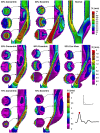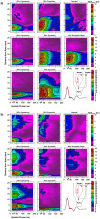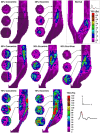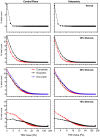In vitro shear stress measurements using particle image velocimetry in a family of carotid artery models: effect of stenosis severity, plaque eccentricity, and ulceration
- PMID: 25007248
- PMCID: PMC4090132
- DOI: 10.1371/journal.pone.0098209
In vitro shear stress measurements using particle image velocimetry in a family of carotid artery models: effect of stenosis severity, plaque eccentricity, and ulceration
Abstract
Atherosclerotic disease, and the subsequent complications of thrombosis and plaque rupture, has been associated with local shear stress. In the diseased carotid artery, local variations in shear stress are induced by various geometrical features of the stenotic plaque. Greater stenosis severity, plaque eccentricity (symmetry) and plaque ulceration have been associated with increased risk of cerebrovascular events based on clinical trial studies. Using particle image velocimetry, the levels and patterns of shear stress (derived from both laminar and turbulent phases) were studied for a family of eight matched-geometry models incorporating independently varied plaque features - i.e. stenosis severity up to 70%, one of two forms of plaque eccentricity, and the presence of plaque ulceration). The level of laminar (ensemble-averaged) shear stress increased with increasing stenosis severity resulting in 2-16 Pa for free shear stress (FSS) and approximately double (4-36 Pa) for wall shear stress (WSS). Independent of stenosis severity, marked differences were found in the distribution and extent of shear stress between the concentric and eccentric plaque formations. The maximum WSS, found at the apex of the stenosis, decayed significantly steeper along the outer wall of an eccentric model compared to the concentric counterpart, with a 70% eccentric stenosis having 249% steeper decay coinciding with the large outer-wall recirculation zone. The presence of ulceration (in a 50% eccentric plaque) resulted in both elevated FSS and WSS levels that were sustained longer (∼20 ms) through the systolic phase compared to the non-ulcerated counterpart model, among other notable differences. Reynolds (turbulent) shear stress, elevated around the point of distal jet detachment, became prominent during the systolic deceleration phase and was widely distributed over the large recirculation zone in the eccentric stenoses.
Conflict of interest statement
Figures












References
-
- Malek AM, Alper SL, Izumo S (1999) Hemodynamic shear stress and its role in atherosclerosis. JAMA 282: 2035–2042. - PubMed
-
- Wentzel JJ, Chatzizisis YS, Gijsen FJH, Giannoglou GD, Feldman CL, et al. (2012) Endothelial shear stress in the evolution of coronary atherosclerotic plaque and vascular remodelling: Current understanding and remaining questions. Cardiovasc Res 96: 234–243. - PubMed
-
- Slager CJ, Wentzel JJ, Gijsen FJH, Thury A, van der Wal AC, et al. (2005) The role of shear stress in the destabilization of vulnerable plaques and related therapeutic implications. Nat Clin Pract Cardiovasc Med 2: 456–464. - PubMed
-
- Gijsen FJH, Wentzel JJ, Thury A, Mastik F, Schaar JA, et al. (2008) Strain distribution over plaques in human coronary arteries relates to shear stress. Am J Physiol Heart Circ Physiol 295: H1608–H1614. - PubMed
-
- Groen HC, Gijsen FJH, van der Lugt A, Ferguson MS, Hatsukami TS, et al. (2007) Plaque rupture in the carotid artery is localized at the high shear stress region - a case report. Stroke 38: 2379–2381. - PubMed
Publication types
MeSH terms
Grants and funding
LinkOut - more resources
Full Text Sources
Other Literature Sources
Research Materials
Miscellaneous

